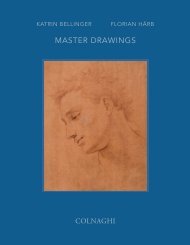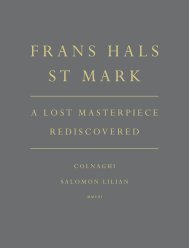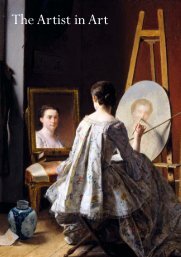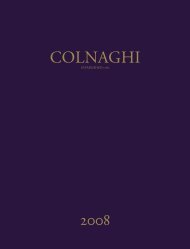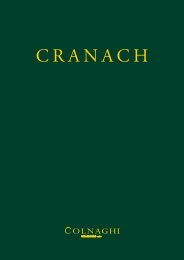2007 Catalogue - Colnaghi
2007 Catalogue - Colnaghi
2007 Catalogue - Colnaghi
You also want an ePaper? Increase the reach of your titles
YUMPU automatically turns print PDFs into web optimized ePapers that Google loves.
Provenance: (Possibly) by descent from Sir William<br />
Ponsonby, (1704-1793), 2nd Earl of Bessborough<br />
(Liotard's patron) to: Claude A. C. Ponsonby, by<br />
whom sold, Christie's, London, 28 March 1908, lot<br />
77, (as J.-E. Liotard); Private collection, Switzerland.<br />
Literature: A. Graves, Art Sales Index from Early in the<br />
Eighteenth Century to Early in the Twentieth Century<br />
(Mostly Old Master and Early English Pictures), vol. I,<br />
Bath, 1973, p. 178; E. Deuber-Pauli and J. D.<br />
Candaux, Voltaire chez lui, Genève et Ferney, Geneva,<br />
1994, pp. 108-110, 132, reproduced p. 110, fig. 5 (as<br />
probably by Liotard after Huber); G. Apgar, L'Art<br />
singulier de Jean Huber, voir Voltaire, Paris, 1995, pp.<br />
94-98, p. 229, no. 101 (as by Huber, or after him,<br />
possibly by Liotard); To be included in Prof. Marcel<br />
Rothlisberger forthcoming book on Liotard as by<br />
Huber.<br />
Our picture relates to Huber’s most important<br />
commission, the Voltairiade, a series of paintings<br />
depicting scenes from Voltaire’s everyday life executed<br />
for Catherine II of Russia circa 1770 to 1775. Huber<br />
was a friend and neighbour of Voltaire, and, perhaps<br />
inspired by the realism that characterised Voltaire’s<br />
philosophy and writings, he depicts the great thinker,<br />
often humorously, in everyday situations. Of the series,<br />
his wife Mary writes: Mon mary [sic] travaille a present<br />
a une Voltairiade...sera une vintaine de petits tableaux<br />
en huille qui representeront diverses scènes de la vie<br />
domestique de Voltaire...Mon mary les a chargé d’un<br />
present pr. Dame Catherine pour la remercier…c’est une<br />
vüe des Alpes où est Voltaire comme hors d’oeuvre avec un<br />
jeste d’entousiasme en voyant un groupe de villageoix. 1<br />
Huber planned in fact to produce four groups of four<br />
paintings, each on a particular theme – domestic life,<br />
the theatre, country life and ‘la vie cavaliere.’ 2 It seems,<br />
however, that the series was never completed and<br />
Huber appears to have stopped working on it in c.<br />
1775. Nine works have survived (the majority c.55 x<br />
20<br />
Jean Huber<br />
(Geneva 1721 – 1786 Bellevue, near Lausanne)<br />
Voltaire narrating a Fable<br />
Oil on panel<br />
13 x 9 in. (33 x 22.7 cm.)<br />
64<br />
45 cm; Hermitage, St. Petersburg), 3 and Huber made<br />
several versions of some from the cycle, the best known<br />
being Voltaire’s Morning Levée. While the Hermitage<br />
pictures are on canvas, our painting is on panel and of<br />
slightly smaller dimensions.<br />
In 1771 Liotard produced a version of Huber’s Voltaire<br />
narrating a Fable in enamel (now lost) which was<br />
almost identical to our panel, with the exception of the<br />
fact that the peasants are shown eating and drinking.<br />
This enamel, which was offered unsuccessfully to the<br />
Comte D’Angiviller for proposed inclusion in the<br />
French Royal collection, was exhibited twice for sale<br />
in London in 1773 and 1785. With the exception of<br />
Liotard’s lost enamel none of the extant versions of this<br />
subject are by Liotard. Rothlisberger4 notes that<br />
previous catalogue citations are incorrect and, in fact,<br />
what was being referred in past literature was<br />
Liotard’s enamel which he copied from our painting. 5<br />
Interestingly, our painting was the only work by Huber<br />
of which Liotard copied – an indication of the<br />
particular esteem in which he held it.<br />
Although Huber was to become an important<br />
founding figure of the Geneva school, he received no<br />
formal training. From a young age, however, he cut out<br />
of paper and card profiles of a kind that later became<br />
known as silhouettes. He also invented what he called<br />
tableaux en découpures, which were depictions of a<br />
range of subjects cut in vellum or parchment. Thanks<br />
to his association from 1759 with Melchior Grimm,<br />
who promoted his art among the readership of his<br />
cultural newsletter the Correspondence litéraire, such<br />
works enjoyed great popularity - George III, for<br />
example, bought a set of découpures. In the 1760s<br />
Huber began to paint landscapes in the style of Philips<br />
Wouwerman, while in the following decade he focused<br />
on the Voltairiade and training his son, Jean-Daniel.



